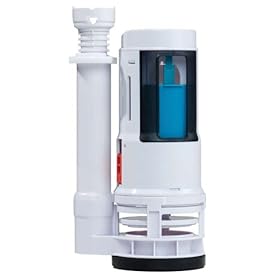We moved to a rental house recently, and the toilet (just one bathroom) we got was put into the house in 1990. Therefore, it uses 3.5 gallons per flush. Obviously, a no-brainer to replace it with something better.
Instead of completely ripping out the toilet and replacing it, and sending the old toilet to the landfill, we looked at an alternative option.
There are now products on the market that will reduce your water amount per flush without buying a new one, and give you an option for a partial flush.
I purchased the
One2flush 200 Dual Flush Retrofit Kit, and planned to reduce my usage to something similar to a 1.3 - 1.6 gallons per flush level, plus have the option to use the low flush option (for liquids).
When I went to install the product, I had problems getting the wing nuts off the back of the toilet, that connects the tank to the bowl. It must have rusted or sealed on there tight, as I spend almost 2 hours trying to get them off. I got one off finally, and tried to loosen the other by pulling and lifting on the tank.
As expected, I cracked the tank. So much for a zero waste solution!
Now I still had a bolt attached to the bowl, and a broken tank. I checked the local Restore, but they only sold toilets as one piece, not the tank or bowl separately. Since we only have one bathroom, I was in a time crunch to get it repaired. The next best option was to buy a new toilet tank.
The new tank was rated for 1.6 gallons per flush, which is better than what we had, but unfortunately, they didn't sell the 1.28 gpf model as a stand-alone option. Only in the full kit version. Which brings me to a quick rant: Why can't you buy each piece individually? There are pieces you should be able to save (lid, base bowl, plunger, water tubes, etc), so it seems wasteful to have to replace every piece of the toilet.
I finally got the retrofit dual-flush kit installed, which was pretty simple to install. There is some adjustment you'll need to make on the different flush levels, but the option to adjust it is nice to have.
Overall, I ended up with a better solution.
Toilet before, each flush = 3.5 gpf
Toilet after, each flush = 1.6 gpf for full, and approx 0.75-1.0 gpf for half flush
I wish I wouldn't have broken the tank, but this is just another example of why it can be tough to do the right thing. I hope my experiences give people some reminders to keep plugging along with your eco-friendly lifestyle, even when things go wrong, and you end up making a worse impact on the environment than you intended.














